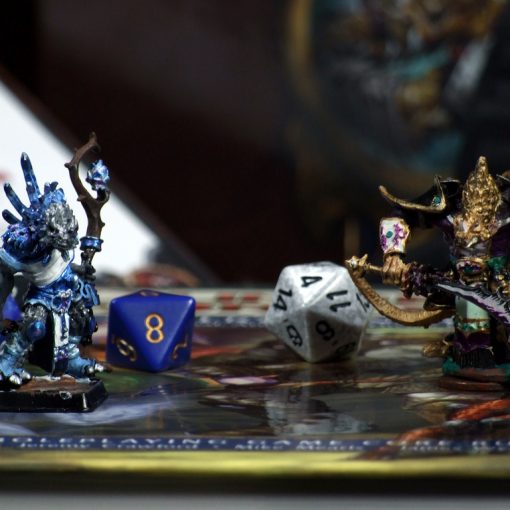In my last blog post, I lamented the heaviness of the GURPS system relative to my own available prep time and went over some of my thought process in finding a new system. This week, having settled on FATE, I’m going to go over some of the specifics of converting the game over. I’m far from an expert at this, so take this more as a set of observations than any sort of useful guide.
First and foremost, I have definitely decided on FATE. I snagged the FATE Core System from my friendly but sadly not-very local game store, Games Plus in Mt. Prospect, IL. I’ve also ordered a set of FATE dice and the toolkit book online. I feel a little bad not having grabbed those at the store too, but it’s over an hour’s drive and I wasn’t as sure that I’d be using FATE when I bought the core book as I am now.
Here’s what FATE has that’s making it more attractive than GURPS right now:
- It’s simple. While I love GURPS (it was what got me into the hobby in the first place, after all!) and I especially love the newest edition now that I’ve invested in it a bit, you would be hard-pressed to find a playable game system with more pages of rules text. The core book is actually a 2-volume set that clocks in at just under 600 pages, and with the exception of about 50 pages, the entire thing is rules and examples of those rules being implemented. A lot of it boils down to simple concepts, but that is still an impressive corpus of material. And that’s before you get into magic and powers, before you get into advanced technology, before you get deep into the martial arts system – you get the idea. In order to get everything I wanted into the GURPS version of the setting, I was referencing something like twenty separate books. I’m going to be using two books for FATE, and they’re smaller – both in terms of page count and page size. The FATE books are about the same size as a novel, whereas GURPS books use the more traditional RPG form factor.
- That simplicity translates into a shallower learning curve. A FATE character sheet fits on one side of about a half-sheet of paper. If your write small like I do, you could probably fit it on a 3×5 card. By contrast, the GURPS character sheets for the play group filled 3-4 full sheets of paper. This means there is a lot less to keep track of in play, a lot fewer systems to teach, and a generally shallower learning curve. It also knocks GM prep time down dramatically.
- Aspects. I don’t think there’s a rules concept that’s been stolen for homebrewing more than aspects. For those unfamiliar with them, Aspects are a bit of descriptive text such as “Foppish Minstrel” that can be either Invoked (used for the PC’s benefit by spending a fate point) or Compelled (used to their detriment to make the game interesting with a Fate point given as compensation). They’re a really interesting facet of FATE’s game design, and I look forward to seeing the ones my PCs come up with.
- Versatility. It’s going to look different than GURPS, but I’m pretty sure everybody will make the transition. This is a really good thing, because, as I’ve described previously, my player group contains both an artificial intelligence and a wizard. In addition, the world has supernatural monsters, aliens, advanced technology, and so forth. Versatility isn’t just nice or useful, it’s essential.
- Speed of play. There’s not a lot to keep track of in FATE, and it leans heavily on story rather than mechanics. That should allow us to get the most out of our sessions.
- SRD: I have a copy of the rules in print, as does Grant, but the rest of our group can access them for free online without resorting to piracy.
That’s all to the good. There have been some unforeseen consequences, though: FATE is extremely collaborative, to the point where coming up with certain aspects of the world is intended to be a group activity. This is very different from GURPS, which is a more traditional “the GM makes up everything and the players discover it” type of game. To be honest, even though I wasn’t expecting that and could probably work around it, I’m actually looking forward to see how it goes. The other one is that even though I’m not going to be using GURPS for the campaign’s rules per se, I’m probably going to keep a few of those books handy for ideas for story elements, technology, etc.
I know from comments on the prior blog post a few of you out there have had the experience of switching systems on the fly. I’d love to hear how it went and what went into the transition. In the meantime, I’m pretty excited to see what Grant cooks up in his Unknown Armies game.




11 thoughts on “Fitting a Game With a New System”
I also enjoyed GURPS for many years before moving to a more simple game, in my case, Savage Worlds. I really like the FATE Core rules and the fun settings and ideas that have been poured out are intriguing and exciting. It’s a great choice I bet you’ll have a blast with.
God bless you.
Honestly, I feel like the only reason Peter isn’t going with Savage Worlds for this game is that we just wrapped up a cyberpunk Savage Worlds game!
Actually, that and the fact that Savage Worlds isn’t all that lethal and it’s very hard to hurt someone badly enough that they suffer long-term consequences. Fate isn’t particularly lethal either, but long-term consequences are easier to apply, which is good for the grittier, XCOM-like game he’s running.
Yeah – I’d rather not KILL you guys, but there definitely needs to be a sense of threat. Also, I don’t think Egeria could be modeled very well in Savage Worlds.
Savage Worlds is cool, and I will point out the optional setting rules like “Gritty Damage” or some such, but I absolutely understand wanting to change it up. I have been running and playing with those rules for a few years straight and my regular group is very reluctant to change and it drives me crazy. Still, at least I’m gaming.
I agree with you there – I wouldn’t mind settling into a “default system” at some point. Later. Right now, there’s WAY too much I haven’t tried.
I won a full set of GURPS books in a contest recently, and I was immediately overwhelmed. I was also kind of excited about the possibilities, but trying to glean all I could to get a game started quickly was not to be found in either of the basic set books. So I downloaded the GURPS Lite PDF for free, and even THAT, at 32 pages, contains more information than I really need right now.
I really want the people I play with to be able to create their own characters instead of giving them stock characters to work with, because it will allow them to be more invested in the story, and in each other. However, my free time is also at a premium, and it looks like we’d have to spend an entire session on character creation just to make some well-rounded characters in the GURPS system.
I played my first FATE game at Fear The Con 8 (Wayne’s “The Bard’s Bard” game), and I like the simplicity of it, but I also like how it allows for additional quirks here and there. I’ll be exploring that, as well as continuing to develop my own RPG system, so that we can focus on the story and not get bogged down with the mechanics.
Maybe somebody would like to buy some new GURPS books?
Keep the GURPS books. They’re full of fantastic ideas and they’re wonderful as inspiration material even if you never run a GURPS game. I made the mistake of thinning my collection out years ago, and I’ve been systematically re-buying everything I let go ever since. Also: 100-300 point GURPS games are pretty manageable. What I was trying to do was 800-point near-superheroes.
Technically, your first go-round was 1300-point actual-superheroes. Glad you refactored the PCs, honestly; that was kind of ridiculous.
YOW!
I thought I was getting too much of a character when the build for a Shadowrun elf was 400 points.
Totally keep the books, though. They’re some very well researched and fairly broad sources for all kinds of cool facts, ideas and theories.
In my defense – one of the sources was GURPS Black Ops which was 700-point PCs back when half-point ranks in skills was a thing. ;)
Savage Worlds is cool, and I will point out the optional setting rules like “Gritty Damage” or some such, but I absolutely understand wanting to change it up. I have been running and playing with those rules for a few years straight and my regular group is very reluctant to change and it drives me crazy. Still, at least I’m gaming.